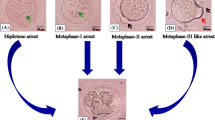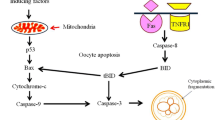Abstract
Programmed cell death (PCD) has been discussed and categorized endlessly over the years. Herein, we comment on the chaotic classification of PCD in the mammalian ovary and the compartmentalized ovarian follicle based on an unfiltered overview of the extent of publication about some of the different modes of PCD on PubMed.

Similar content being viewed by others
References
Kerr JF, Wyllie AH, Currie AR. Apoptosis: a basic biological phenomenon with wide-ranging implications in tissue kinetics. Br J Cancer. 1972;26(4):239–57.
Liu X, et al. There are only four basic modes of cell death, although there are many ad-hoc variants adapted to different situations. Cell Biosci. 2018;8:6.
Hussein MR. Apoptosis in the ovary: molecular mechanisms. Hum Reprod Update. 2005;11(2):162–77.
Grive KJ. Pathways coordinating oocyte attrition and abundance during mammalian ovarian reserve establishment. Mol Reprod Dev. 2020;87(8):843–56.
Luo M, et al. miR-137 regulates ferroptosis by targeting glutamine transporter SLC1A5 in melanoma. Cell Death Differ. 2018;25(8):1457–72.
Sun X, et al. HSPB1 as a novel regulator of ferroptotic cancer cell death. Oncogene. 2015;34(45):5617–25.
Akogullari, D., E.T. Uluer, and H.S. Vatansever, Investigation of the relation between follicular atresia and granulosa cells in terms of cell death mechanisms in premature ovarian failure model. Proceedings, 2018. 2(25): p. 1529.
Chaudhary GR, et al. Necrosis and necroptosis in germ cell depletion from mammalian ovary. J Cell Physiol. 2019;234(6):8019–27.
Bonnet A, et al. Transcriptome profiling of sheep granulosa cells and oocytes during early follicular development obtained by laser capture microdissection. BMC Genomics. 2011;12:417.
Titus S, et al. Individual-oocyte transcriptomic analysis shows that genotoxic chemotherapy depletes human primordial follicle reserve in vivo by triggering proapoptotic pathways without growth activation. Sci Rep. 2021;11(1):407.
McEvoy, M.J., et al., Death processes in bovine theca and granulosa cells modelled and analysed using a systems biology approach. Int J Mol Sci. 2021. 22(9).
Overholtzer M, et al. A nonapoptotic cell death process, entosis, that occurs by cell-in-cell invasion. Cell. 2007;131(5):966–79.
Wang, D., et al., Loss of 4.1N in epithelial ovarian cancer results in EMT and matrix-detached cell death resistance. Protein Cell, 2021. 12(2): p. 107–127.
Quesada-Candela C, et al. Molecular basis of reproductive senescence: insights from model organisms. J Assist Reprod Genet. 2021;38(1):17–32.
Perez GI, et al. Prolongation of ovarian lifespan into advanced chronological age by Bax-deficiency. Nat Genet. 1999;21(2):200–3.
De Vos M, et al. Perspectives on the development and future of oocyte IVM in clinical practice. J Assist Reprod Genet. 2021;38(6):1265–80.
Saunders, P., The comparative behavior of mammalian eggs in vivo and in vitro. VI. The maturation of human ovarian ova. The Anatomical Record. 1939. 75(4): p. 537–545.
Vuong LN, et al. Live births after oocyte in vitro maturation with a prematuration step in women with polycystic ovary syndrome. J Assist Reprod Genet. 2020;37(2):347–57.
Author information
Authors and Affiliations
Corresponding authors
Ethics declarations
Conflict of interest
The authors declare no competing interests.
Additional information
Publisher's note
Springer Nature remains neutral with regard to jurisdictional claims in published maps and institutional affiliations.
Rights and permissions
About this article
Cite this article
Dey, P., Luciano, A.M. A century of programmed cell death in the ovary: a commentary. J Assist Reprod Genet 39, 63–66 (2022). https://doi.org/10.1007/s10815-021-02389-6
Received:
Accepted:
Published:
Issue Date:
DOI: https://doi.org/10.1007/s10815-021-02389-6




